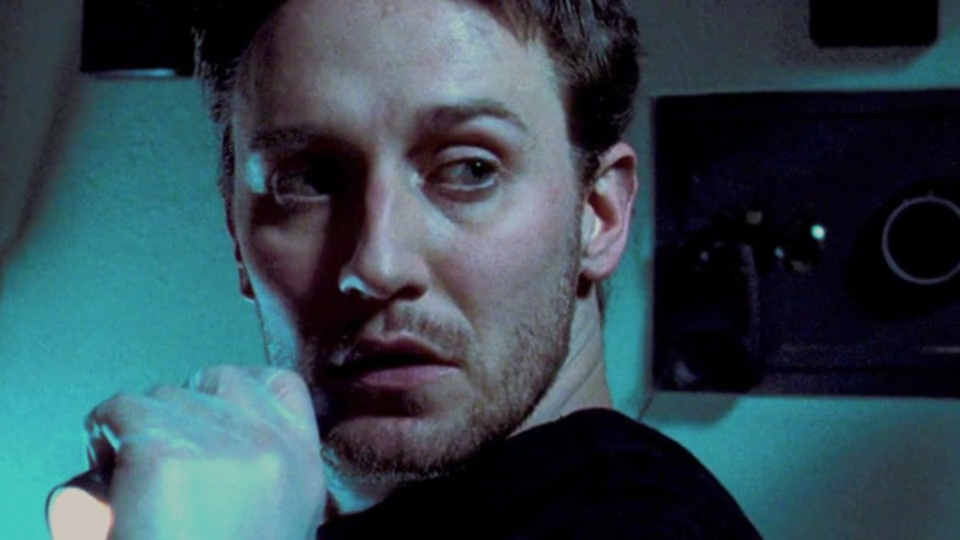The Collector

In horror films, smart protagonists are rare. Usually, they’re beholden to lazy writing that sees them running up the stairs instead of out the door. Not so in The Collector, where our protagonist makes the same smart decisions we think we would make in his shoes, making for a surprisingly engaging ride that overcomes a major plot hole.
The premise involves Arkin, a thief, played by Josh Stewart, who breaks into a jeweler’s remote country house planning to steal a massive gem, only to discover a masked killer has broken in, kidnapped the jeweler’s family, and is torturing them in the basement. Arkin tries calling for help but finds the phone dead. He then tries to flee through a window and has his hand sliced by razor blades. Trapped, Arkin resolves to rescue the family, but to do so he must navigate the house laden with death traps while avoiding the killer.
It’s a great premise—like Die Hard mixed with Saw, you have an antagonist’s plan interrupted by a “fly in the ointment.” Indeed, writer-director Marcus Dunstan and co-writer Patrick Melton had previously written multiple entries in the Saw franchise. But unlike those films, which were essentially showcases for the inventive traps, The Collector features a memorable protagonist in Arkin who, thanks to his level head and ample agency, generates more emotional investment than any Saw installment, even the original.
But about that plot hole.
Arkin leaves the house in the afternoon, then returns later that evening for the robbery. Being generous, that would give the killer six hours to subdue and secure the family and rig all the traps. On my first watch, I found this preposterous. Given the sheer number of snares staged throughout the house, it would take a single person days to rig them all. Consider how the dining room features dozens of bear traps covering the floor. If we assume each weighs around fifty pounds, it would take a single person a couple hours at best to stage just that room.
But then, on my second watch, I realized when Arkin breaks in, many of the traps aren’t yet present. He moves through the dining room devoid of bear traps. On his way upstairs, he passes through an archway that later features a spider-web of razor wire. Indeed, we’re expected to believe the killer sets these traps in a matter of minutes after realizing there’s someone else in the house. That’s a big plot hole.
But you know what? I can get past it. Dunstan and Melton likely knew it was a gap, but rather than add some awkward exposition to try and address it—calling it out in the process—they keep the film lean. Plot hole aside, the script proves remarkably efficient.
Clocking in under ninety minutes (including credits!) the script hews relentlessly to the “show, don’t tell” mantra. Consider how it establishes Arkin’s cool-under-pressure personality with a scene showing him hanging some bars outside a window. As he goes to pick up the apparatus, a wasp lands on his hand. Then another, and another. Glancing up, he sees a tire-sized nest just out of arm’s reach. Rather than panic, or even try to swat the wasps away, he calmly puffs smoke from his cigarette, causing the wasps to disperse.
That’s a terrific scene. Filled with relatable tension, it foreshadows the bars that figure later in the story, while also establishing Arkin as someone who doesn’t rattle.
Visually, the film shines as well. While it does feature the green and yellow hue popularized by the Saw franchise, Dunstan and cinematographer Brandon Cox elevate the film beyond a Saw knock-off.
Consider the early scene where Arkin drives to the house for the robbery. We get a bird’s-eye view, shot with inverted colors, of his car winding through the desolate road surrounded by trees. It establishes both the house’s remoteness, and that Arkin is entering nightmare territory.
Then later, in my favorite shot, Arkin hears the killer approach. As he moves into an adjoining room, the camera rises through the ceiling. We see Arkin and the killer move in lock-step to opposite sides of a door. Neither opens it. Instead, they both freeze, listening for each other.
Finally, there’s the tone. In perhaps the film’s strongest achievement, Dunstan and Melton do a masterful job of ratcheting up the violence.
The first instance comes when Arkin tries to call for help. Unbeknownst to him, the killer has placed a long tack on the phone’s earpiece, which pierces Arkin’s ear as he goes to make the call. A flesh wound, but a relatable one the audience can almost feel.
From there, the violence intensifies, leading to a gruesome disembowelment. Had the film stopped here, it likely wouldn’t have worked, but Dunstan and Melton escalate to cartoonish levels. The family cat meets a gruesome and over-the-top end, the killer’s dog becomes a flaming projectile, and an unfortunate victim meets the bear traps. Besides providing some welcome black comedy, pushing the violence to cartoonish levels makes it easier to overlook the aforementioned plot hole; after all, you never scoff at Wile E. Coyote’s ability to construct those elaborate traps for the Road Runner.